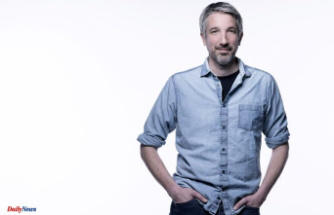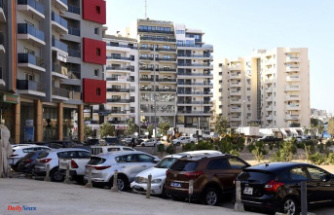It smells beguiling between the lavender plants. A path leads through the pleasing landscape, past sea pine, cypress and cedar of Lebanon, past fields of wild roses. And again and again lavender, you think you are walking on the Mediterranean. But through the buzzing of the bees and bumblebees and the many bird calls, the noise of the federal highway 239 penetrates. This is not southern France, but the Lipperland near Lage. Where they grow lavender, in the very east of North Rhine-Westphalia, and have been for almost ten years. For perfumes, scents and natural cosmetics.
During a walk in the visitor garden of Taoasis near Lage, Katharina Tenbrink explains the processes of cultivation and fragrance production. The chemist is in charge of quality assurance at the manufactory that grows the lavender in Lipperland. "The harvest is always around midday, when the sun, i.e. the warmth of the day, has drawn a lot of oil into the flowers," explains Tenbrink. The weeks leading up to the harvest shouldn't have been completely rainy, and fortunately that wasn't the case this year either.
The largest lavender fields in Lippe, around five hectares, are located in the visitor garden and will soon be harvested. The harvest has already been brought in on the fields in Fromhausen and Mosebeck, which Taoasis also farms. Three people in particular have kept a close eye on the lavender fields since spring: company founder Axel Meyer, employed farmer Luis Rehermann and Katharina Tenbrink.
The lavender people can't change anything about the weather, but they can change some parameters: "In addition to the large fields for production, we also have test fields," reports Katharina Tenbrink. The amount of natural fertilizers is also varied there, as permitted by Demeter, the oldest German organic association.
She goes into a field and plucks lavender, rubs a bud and smells it. What is more important - your nose or the gas chromatograph in the laboratory? "Both! After ten years of lavender cultivation here in Lippe, it is of course experience, but also the intuition for the right moment to harvest.”
Axel Meyer came up with the idea of founding a fragrance manufactory about 30 years ago. In 1991, inspired by numerous trips to Asia and South America, he published a "Lexicon of Fragrances". As a result, the demand for natural essential oils increased so much that Meyer decided to found Taoasis. The name is a synthesis of the Chinese "Tao" and the Arabic "Oasis" and loosely translated means "life in harmony with nature", explains Katharina Tenbrink.
The idyllic images of people walking through the fields by hand and with a sickle to harvest the lavender are also a thing of the past in Lippe, although that was common until a few years ago. Today a French lavender harvester is in use, which rides along on the side of the tractor during the harvest.
"The harvest goes into this vessel," says Katharina Tenbrink, pointing to a stainless steel container. "This is closed, then water vapor is passed through the flowers, the hot steam takes the essential oil with it." Once the steam-oil mixture condenses, it separates, the oil sought is drained into the "Florentine Vase", a small one Glass vessel in which the valuable oil collects.
"We gain around half a liter per distillation process," explains Katharina Tenbrink. Since only comparatively little oil can be obtained from the own lavender harvest so far, this is only processed further in a few selected products. For example in room sprays and small fragrance rollers for the skin. In other products, ten percent of the local lavender oil is used, the rest is jojoba oil. It comes from the seeds of a shrub plant native to the western United States and northwestern Mexico.
"We also buy lavender oil in organic or Demeter quality from various cultivation partners around the world," reports the chemist. At least so far. Because since the move to the new location in Lage last year, another five hectares of lavender fields have been added.
The people here not only know the secret of distilling the scent out of lavender. On the way from the field to the distillery, the path also led past fields full of peppermint and spearmint that smelled of chewing gum. Katharina Tenbrink rubs and smells the clary sage and lemon balm.
Yarrow, rosemary and immortelle are also grown. In addition, mountain savory and oregano – oil is also distilled from them. Also from oranges, lemons, cedars and many other plants and raw materials, which are bought in.
In the meantime, their own lavender oil has found its way from the field into the bottle. Katharina Tenbrink's actual work area is in a laboratory where quality control takes place. And emotional processes also take place here. In the laboratory, employee Sara Lamm composed a perfume last year. "My task was to develop a fresh, floral fragrance," she recalls. "A perfume or a fragrance composition is structured like a pyramid, consists of a head, heart and base."
What attracts a beautiful, pleasing scent? What keeps him, what stays? Which oil, which individual fragrance could, could and should it be? What goes together and what doesn't? After researching the literature, Sara Lamm spent weeks at the fragrance shelf. Here, in the collection - perfumers speak of a scent organ - the Lippe lavender oil can be found again.
Connoisseurs of the subject matter can play on a scented organ like a musician on a real organ. A piece emerges from the single note, a pleasing composition, and is discarded a hundred times on the way there. It's the subtleties that make the piece ring and vibrate, that create a feeling, bring it back, let it live.
A good perfume is more than the sum of its individual fragrance oils. Incidentally, in the case of the perfume mentioned, vanilla, orris root and rose. At least that's what Katharina Tenbrink says. But not a word more, the exact perfume recipes are a closely guarded secret.
In the warehouse, three employees are standing in front of a locked steel cabinet, the key has to be fetched separately. On the bottom of the cupboard, just to keep him from falling, is a carboy, a large, bulbous bottle encased in Styrofoam.
A pale golden liquid quivers in the bottle and shimmers strangely and mysteriously in the light. Lippe lavender oil. The fragrant essence of this Westphalian Provence.












